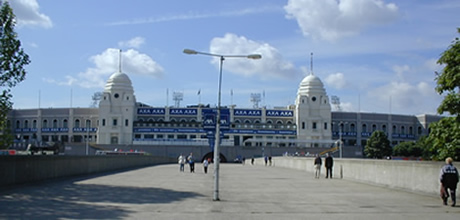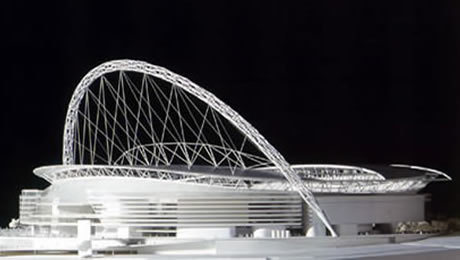Wembley Stadium
Past, present and future
The development of the Wembley site goes back as long ago as the 1880's when the site was known as Wembley Park Leisure Grounds. It had football and cricket pitches, a running track, fountains and waterfalls, walkways and flower beds.
In 1889, in a bid to encourage more people to use the railways, Sir Edward Watkin - Chairman of the Metropolitan Railway, decided to build a main attraction at the site linked to central London by railway. He aimed to build a 1,150 foot high four legged tower to rival Paris's Eiffel Tower within the leisure grounds. However during construction of the first stage, the foundations moved and the project ran out of money. When work on the tower was abandoned it had only reached 200 feet high and became known as Watkins Folly - a curious tourist attraction in its own right. It was dynamited out of existence in 1907.

At the end of the Great War in 1918, the Government began planning a British Empire Exhibition with a stadium acting as a National Sports Ground as its centrepiece. The Wembley Park Leisure Ground which had now evolved into an 18-hole golf course was selected as an ideal site. The Exhibition area covered 219 acres and the area in which Watkins Folly had stood was chosen as the site for the new stadium.
The Empire Stadium as it was originally known, was built by architect Sir John Simpson and Maxwell Ayerton, and the engineer Sir Owen Williams. The foundation stone was laid by the Duke of York on the 10th of January 1922 and it took just 300 days to complete at a cost of £750,000, and was built from 25,000 tons of ferro concrete, 1000 tons of steel and over half a million rivets.
The Empire Exhibition was truly a wonder of the world with fountains, lakes, gardens and hundreds of pavilions representing the architectural styles of the countries exhibiting there. It was opened by King George V on 23rd April 1924, and attracted millions of visitors. It re-opened between May and October the following year which lifted the final attendance to 27,102,498 with four and a half million visitors to the Empire Stadium alone.
The first event at the stadium was the famous 'White Horse Cup Final' of 1923. Over 200,000 fans crammed into the ground to watch the F.A. Cup Final between Bolton Wanderers and West Ham United. Play only commenced after the persuasive efforts of P.C. Scorey cleared the pitch on his horse 'Billy'. Wanderers won 2-0.
The Stadium becomes Legendary
The stadium was brought in 1927 by the visionary entrepreneur Arthur Elvin. He introduced Greyhound Racing, Speedway and Rugby League. In 1946 he was knighted as recognition for his endeavors and war effort. 1948 saw Wembley host the Olympic Games with Dutch housewife Fanny Blankers-Koen becoming the star winning an amazing four gold medals. Wembley's enduring appeal was secured in 1966 when England beat West Germany 4-2 on it's famous turf and became football's World Champions.
Recent years have seen Wembley host many more memorable occasions, and not for football. Famous names such as Michael Jackson, The Rolling Stones, Tina Turner, U2 and Madonna have performed in the stadium as well as The Pope and The 3 Tenors.
Wembley was again the spotlight of the world, when in 1985, Live Aid was staged at the stadium with a memorable performance from Queen. They went on to play at the stadium a year later and then again sadly in 1992 when the three remaining members of the band teamed up with music's greats for the Freddie Mercury Tribute Concert.
It's football that still gets the attention though, with recent events including the 1996 European Championships which culminated in the final between the Czech Republic and Germany (although many would say the real final was between England and Germany in the Semi-Final - but lets not dwell on that!)
![]() The last few years, Wembley has seen greater focus on that of its successor. After it was decided that a new national stadium to replace Wembley should stay at Wembley, plans were drawn up, proposals made then with govenment intervention (as with most things the goverment touches) everything looked like it had fallen apart.
The last few years, Wembley has seen greater focus on that of its successor. After it was decided that a new national stadium to replace Wembley should stay at Wembley, plans were drawn up, proposals made then with govenment intervention (as with most things the goverment touches) everything looked like it had fallen apart.

However on Friday, February 7th, 2003, at 2:15pm, work finally began to demolish Wembley Stadium's legendary Twin Towers, marking the end of an era, but the beginning of a brilliant new one.
Wembley Stadium
Previous site content, that appeared on LloydyWeb between 2002-2006.
Further Information
- Official Site
- Read more about the venues past, study designs of the new building, watch it being built via the webcams and get a small glimpse of England's footballing future!
Shop with Amazon.co.uk
- Wembley: The Greatest Stage
- This book tells the story of Wembley Stadium, through the memories and pictures of those who've played, worked or watched since 1923.
